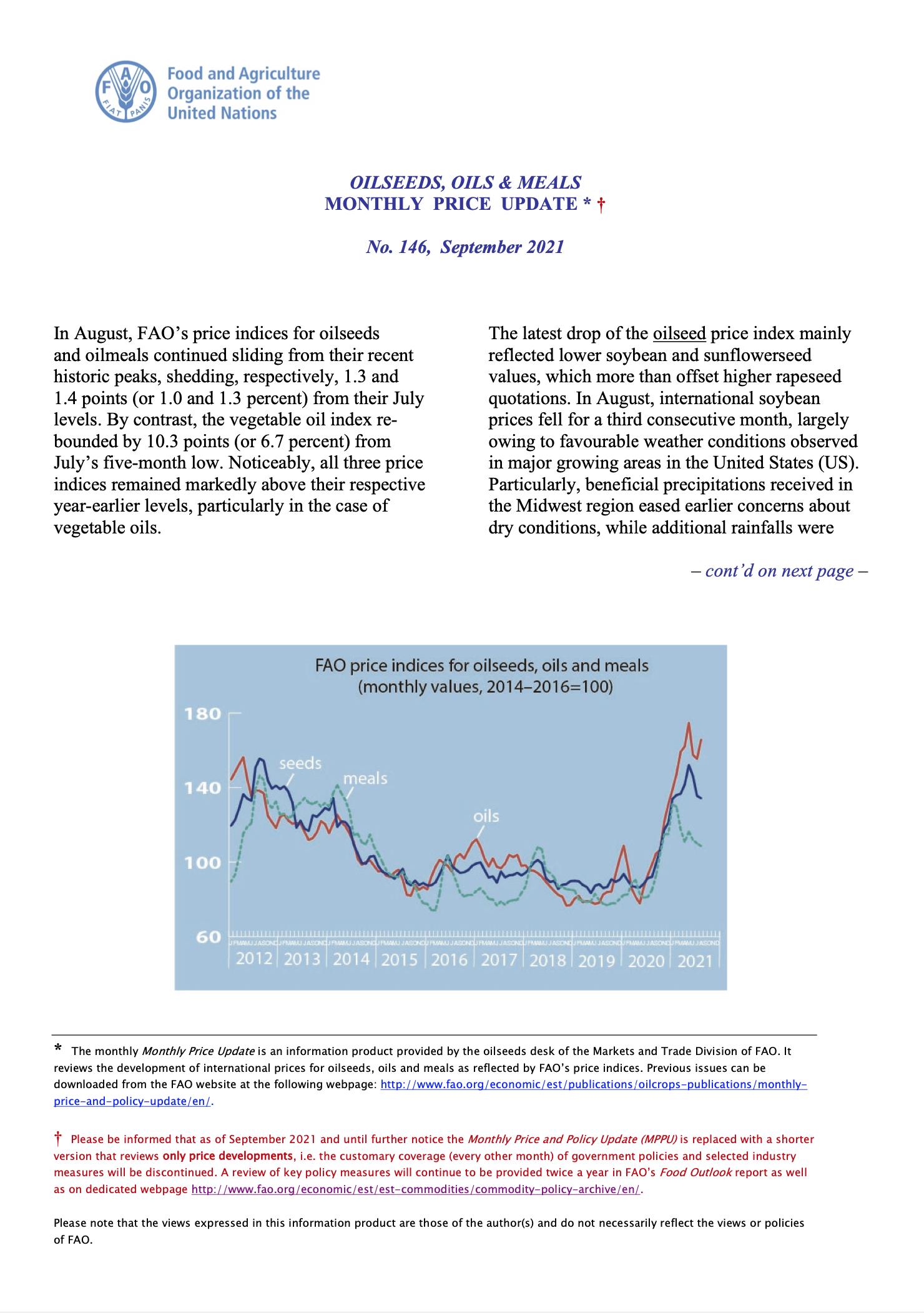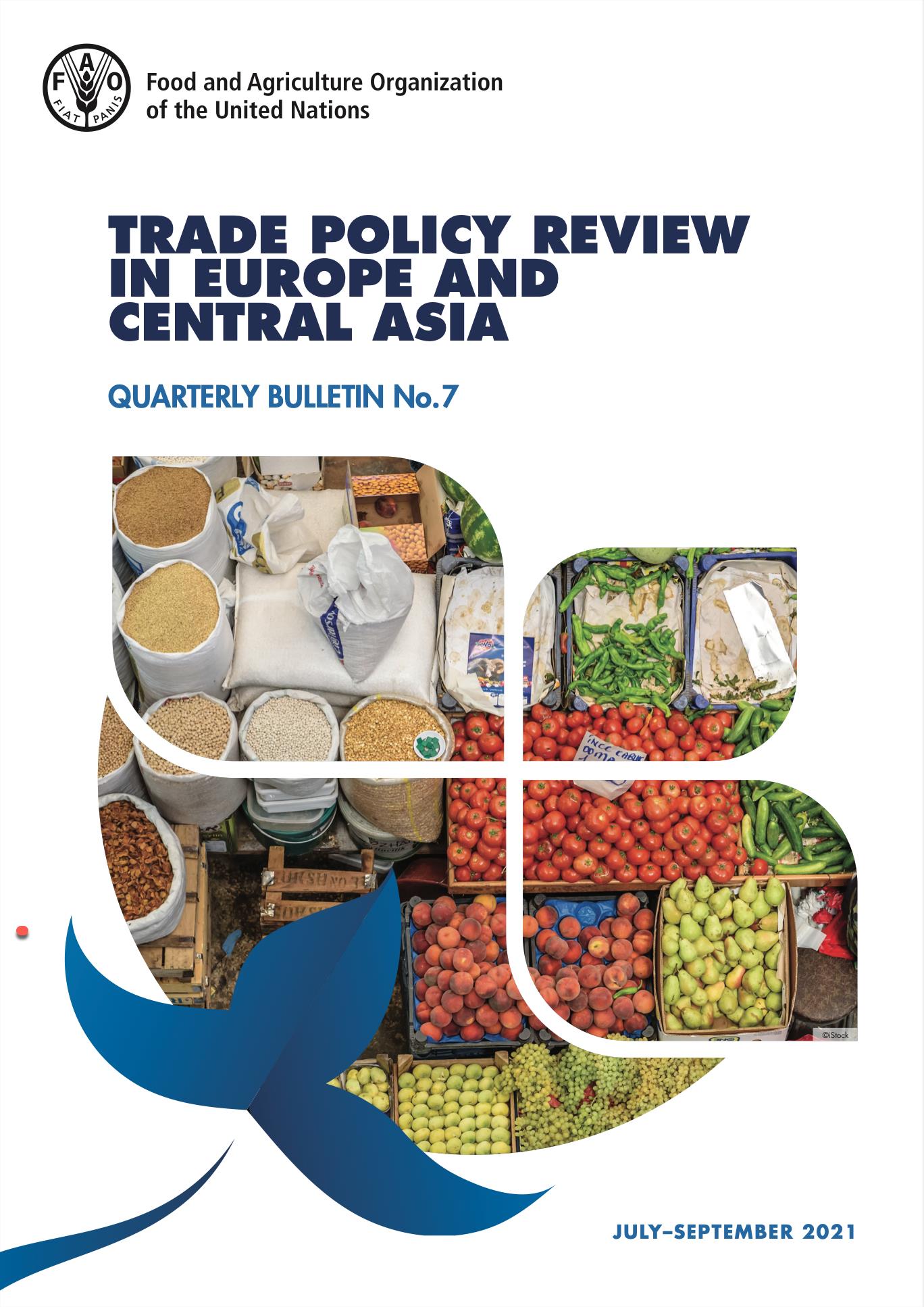
Trade Policy Review in Europe and Central Asia - Quarterly Bulletin No. 7
13/10/2021
This quarterly bulletin features agricultural trade policy changes in the region. It provides current trade measures, agreements, statistics and articles by experts covering trade-related issues in countries across the region, and it is sent to members of the Agricultural Trade Expert Network.
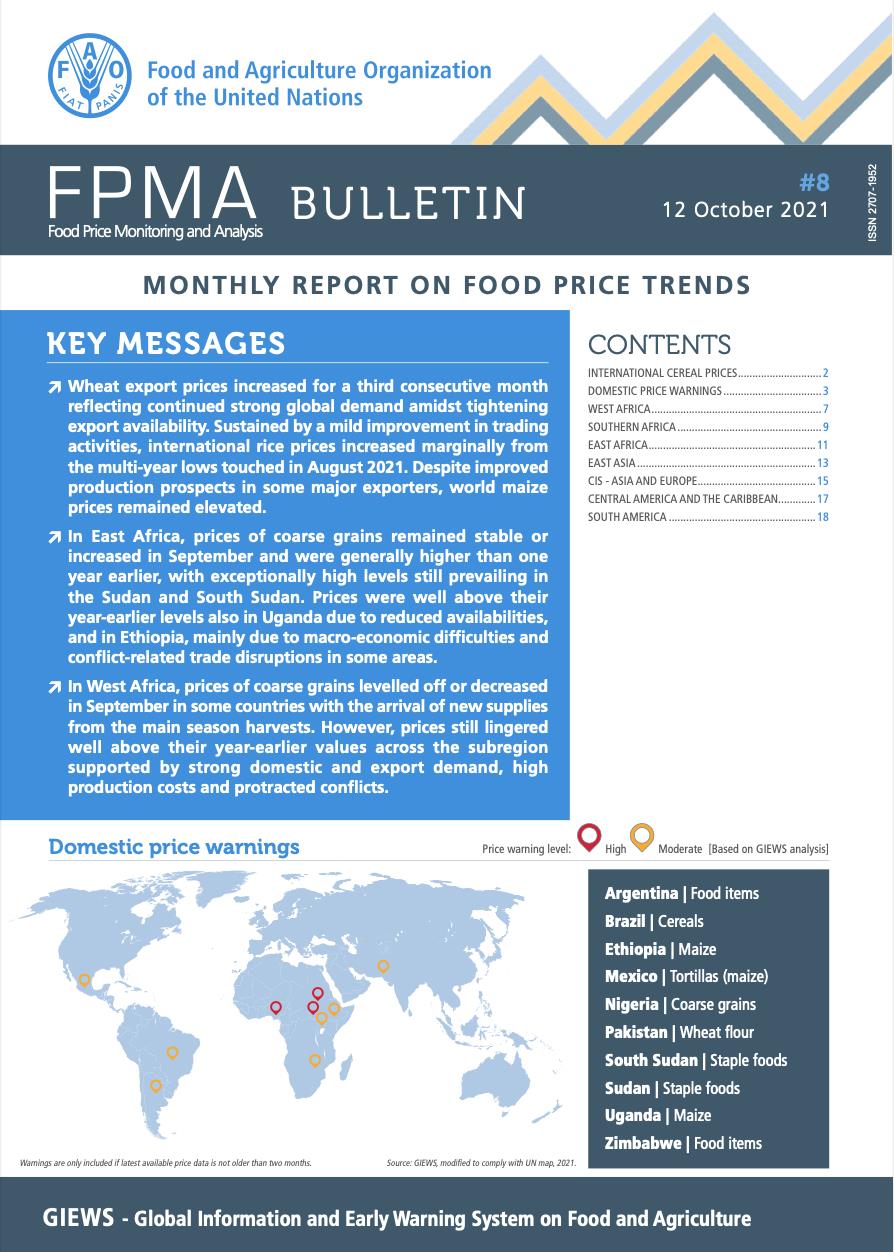
Food Price Monitoring and Analysis (FPMA) Bulletin #8, 12 October 2021
12/10/2021
Wheat export prices increased for a third consecutive month reflecting continued strong demand amidst tightening export availability. Sustained by a mild improvement in trading activities, international rice prices made marginal increases over the multi-year lows touched in August 2021. Despite improved production prospects in some major exporters, maize prices remained elevated. In East Africa, prices of coarse grains remained stable or increased in September and were generally higher than one year earlier, with exceptionally high levels still prevailing in the Sudan and South Sudan. Prices were well above their year‑earlier levels also in Uganda due to reduced availabilities, and in Ethiopia, mainly due to macro-economic difficulties and conflict-related trade disruptions in some areas. In West Africa, prices of coarse grains levelled off or decreased in September in some countries with the arrival of new supplies from the main season harvests. However, prices still lingered well above their year-earlier values across the subregion supported by strong domestic and export demand, high production costs and protracted conflicts.
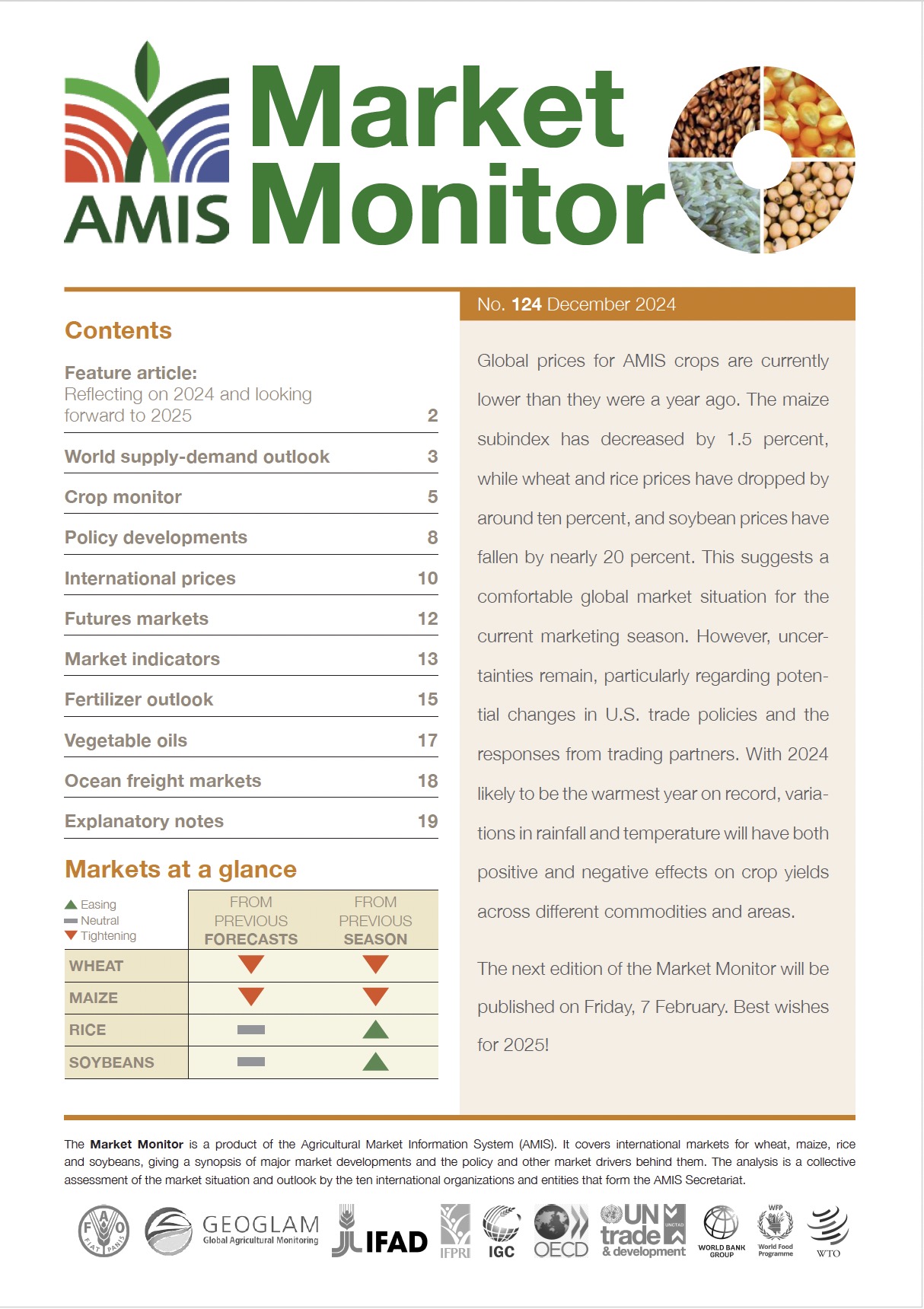
AMIS Market Monitor - No. 92 - October 2021
07/10/2021
How will developments in global food markets in 2021/22 differ from the COVID-19-driven situation of 2020/21? As world economic activity gradually returns to pre-pandemic levels, the likely upward pressure on food demand, along with rising energy prices as well as increased fertilizer and transport costs could further increase the degree of variability and uncertainty in the global food system.

AMIS Market Monitor - No. 124 - December 2024
07/10/2021
The month of May marks the release of the first forecasts for global cereal production, but with many crops yet to be planted in the Northern hemisphere, there is a high level of uncertainty with these projections. This year, the validity of the first forecasts for 2024/25 wheat production is already being tested, as drought and prolonged frost in key producing areas of the Russian Federation have constrained yield prospects.
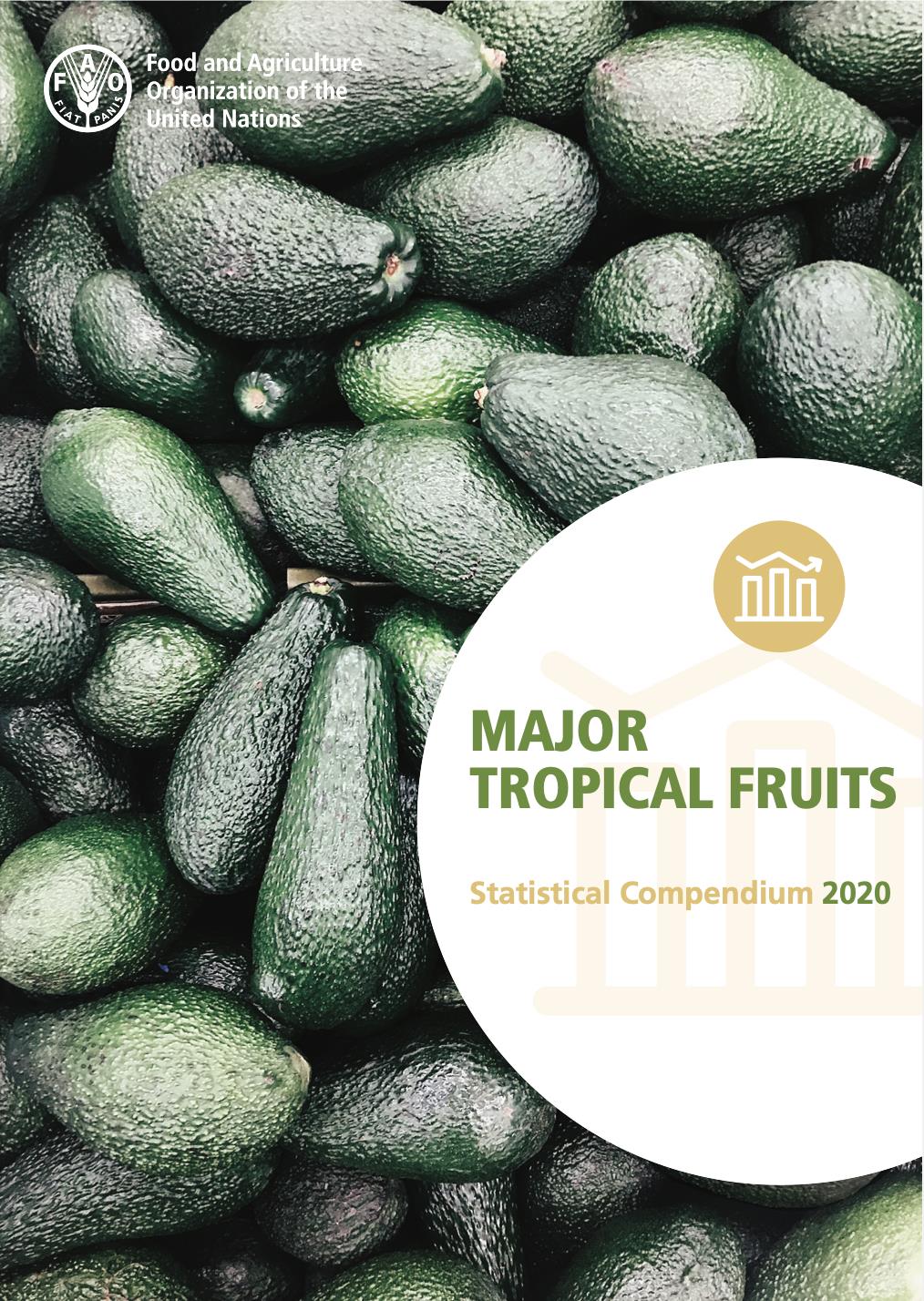
Major Tropical Fruits - Statistical Compendium 2020
07/10/2021
The Major Tropical Fruits Statistical compendium, issued once a year, contains information on global trade in mangoes, pineapples, avocados and papayas. Its sources include information provided by FAO member nations, traders, news bulletins and the opinions of commodity specialists and represents the most authoritative and up-to-date source of information on the world tropical fruit economy.
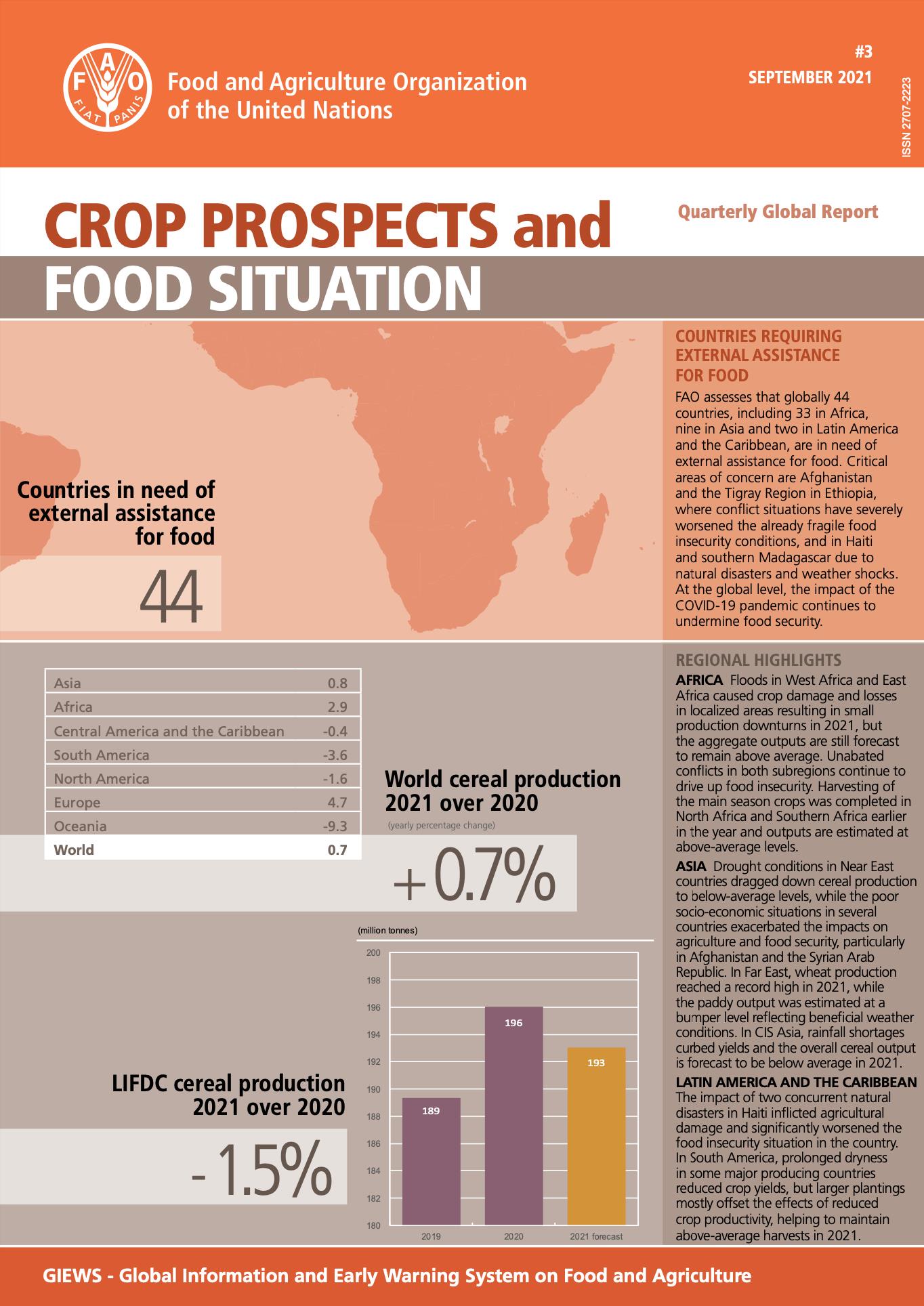
Crop Prospects and Food Situation - Quarterly Global Report, No. 3, September 2021
23/09/2021
FAO assesses that globally 44 countries, including 33 in Africa, 9 in Asia, and 2 in Latin America and the Caribbean, are in need of external assistance for food. Critical areas of concern are Afghanistan and the Tigray Region in Ethiopia, where conflict situations have severely worsened the already fragile food insecurity conditions, and in Haiti and southern Madagascar due to natural disasters and weather shocks.
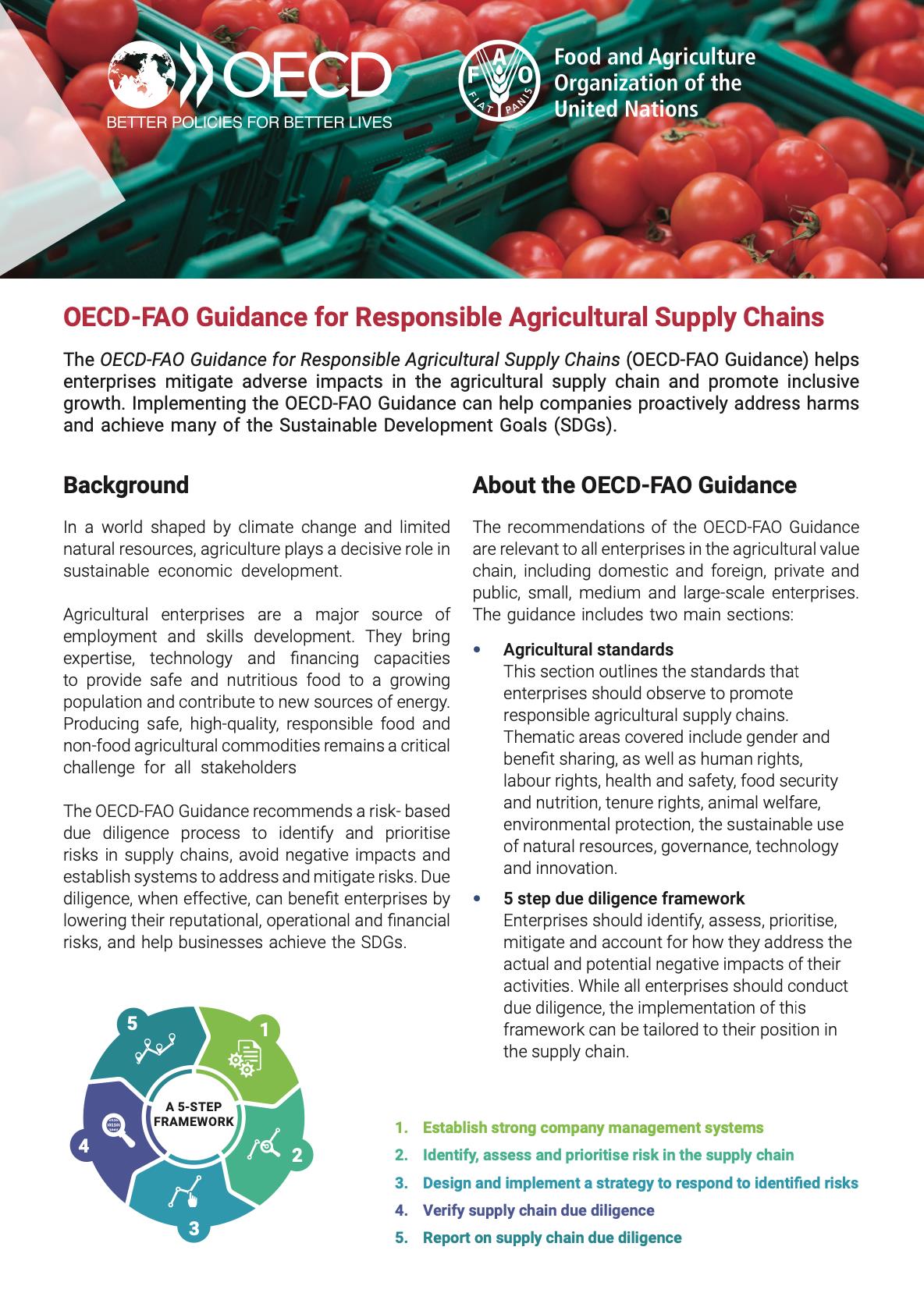
OECD-FAO Guidance for Responsible Agricultural Supply Chains - Brochure
23/09/2021
The OECD-FAO Guidance for Responsible Agricultural Supply Chains (OECD-FAO Guidance) helps enterprises mitigate adverse impacts in the agricultural supply chain and promote inclusive growth. Implementing the OECD-FAO Guidance can help companies proactively address harms and achieve many of the Sustainable Development Goals (SDGs).
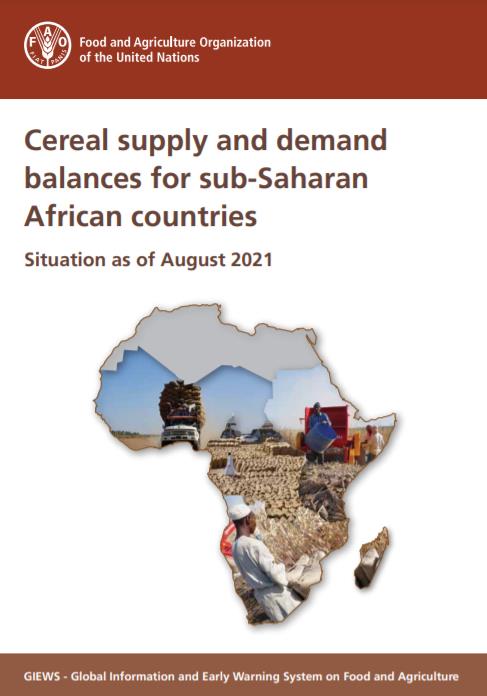
Cereal supply and demand balance for sub-Saharan African countries - No.3, September 2021
23/09/2021
This statistical report contains a subset of CCBS data and presents updated cereal supply and demand balances for all sub-Saharan African countries. It complements the information of the FAO/GIEWS Crop Prospects and Food Situation report and is published four times a year with the same schedule.
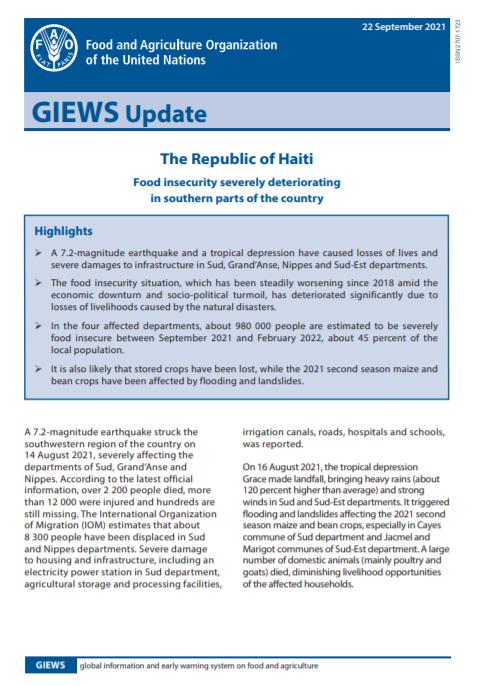
GIEWS Update - The Republic of Haiti, 22 September 2021
22/09/2021
A 7.2-magnitude earthquake and a tropical depression have caused losses of lives and severe damages to infrastructure in Sud, Grand’Anse, Nippes and Sud-Est departments. The food insecurity situation, which has been steadily worsening since 2018 amid the economic downturn and socio-political turmoil, has deteriorated significantly due to losses of livelihoods caused by the natural disasters. In the four affected departments, about 980 000 people are estimated to be severely food insecure between September 2021 and February 2022, about 45 percent of the local population. It is also likely that stored crops have been lost, while the 2021 second season maize and bean crops have been affected by flooding and landslides.
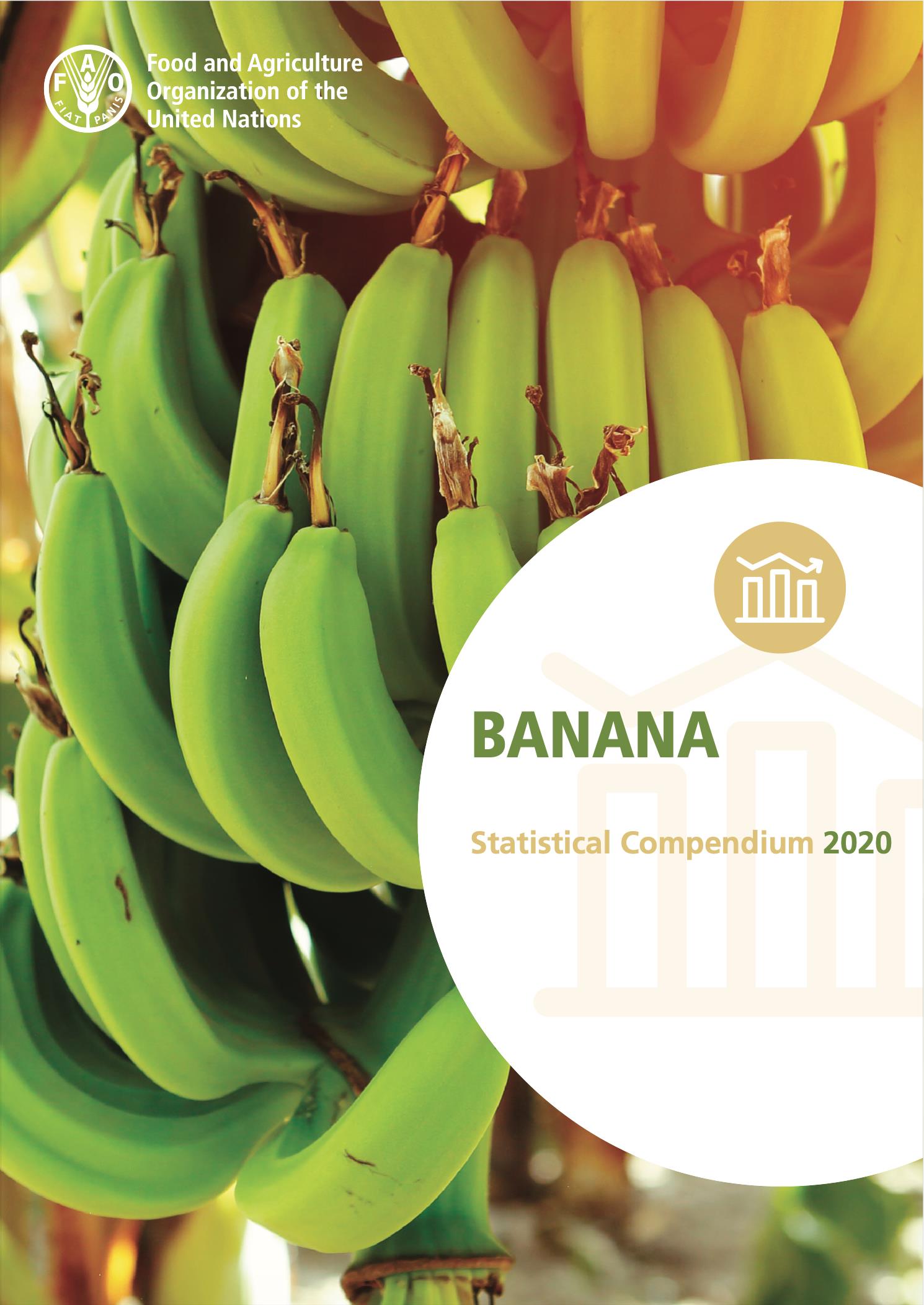
Banana Statistical Compendium 2020
09/09/2021
The Banana Statistical compendium, issued once a year, contains information on global banana trade. Its sources include information provided by FAO member nations, traders, news bulletins and the opinions of commodity specialists and represents the most authoritative and up-to-date source of information on the world banana economy.

Food Price Monitoring and Analysis (FPMA) Bulletin #7, 9 September 2021
09/09/2021
International cereal prices followed mixed trends in August. Wheat prices surged as production prospects deteriorated significantly in several major producing countries. Among coarse grains, reduced production forecasts also boosted barley prices, while maize and sorghum prices continued to decline from their multi‑year highs reached in May. International rice prices remained on a downward trajectory in August, influenced by efforts to attract sales and by currency movements. In East Africa, prices of coarse grains generally increased in August, especially in countries where first/main season harvests dropped sharply. Prices were generally higher than one year earlier, with exceptionally high levels still prevailing in the Sudan and South Sudan. In West Africa, solid domestic demand amidst constrained market availabilities hindered by supply chain bottlenecks and locally volatile security conditions exacerbated seasonal upward trends in the prices of domestically produced coarse grains, which lingered at levels well above their year-earlier values.
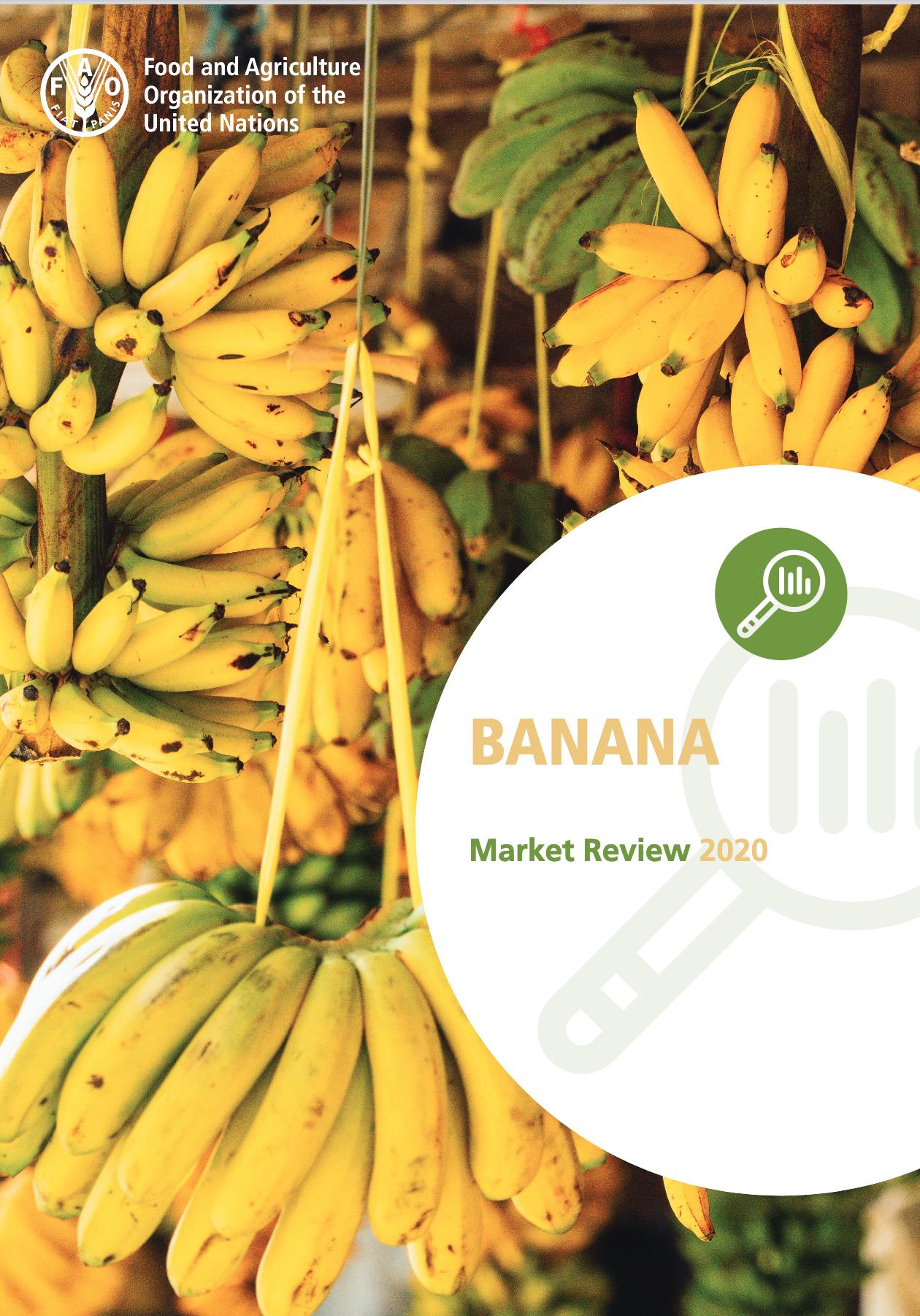
Banana Market Review 2020
09/09/2021
The Banana Market Review is issued on an annual basis to Members and Observers of the Sub-Group on Bananas of the Intergovernmental Group on Bananas and Tropical Fruits, and it offers a comprehensive overview of previous-year developments in banana trade. It is prepared by the Team on Responsible Global Value Chains, Markets and Trade Division, FAO, which provides research and analyses on global value chains for agricultural commodities, and economic data and analyses on tropical fruits.
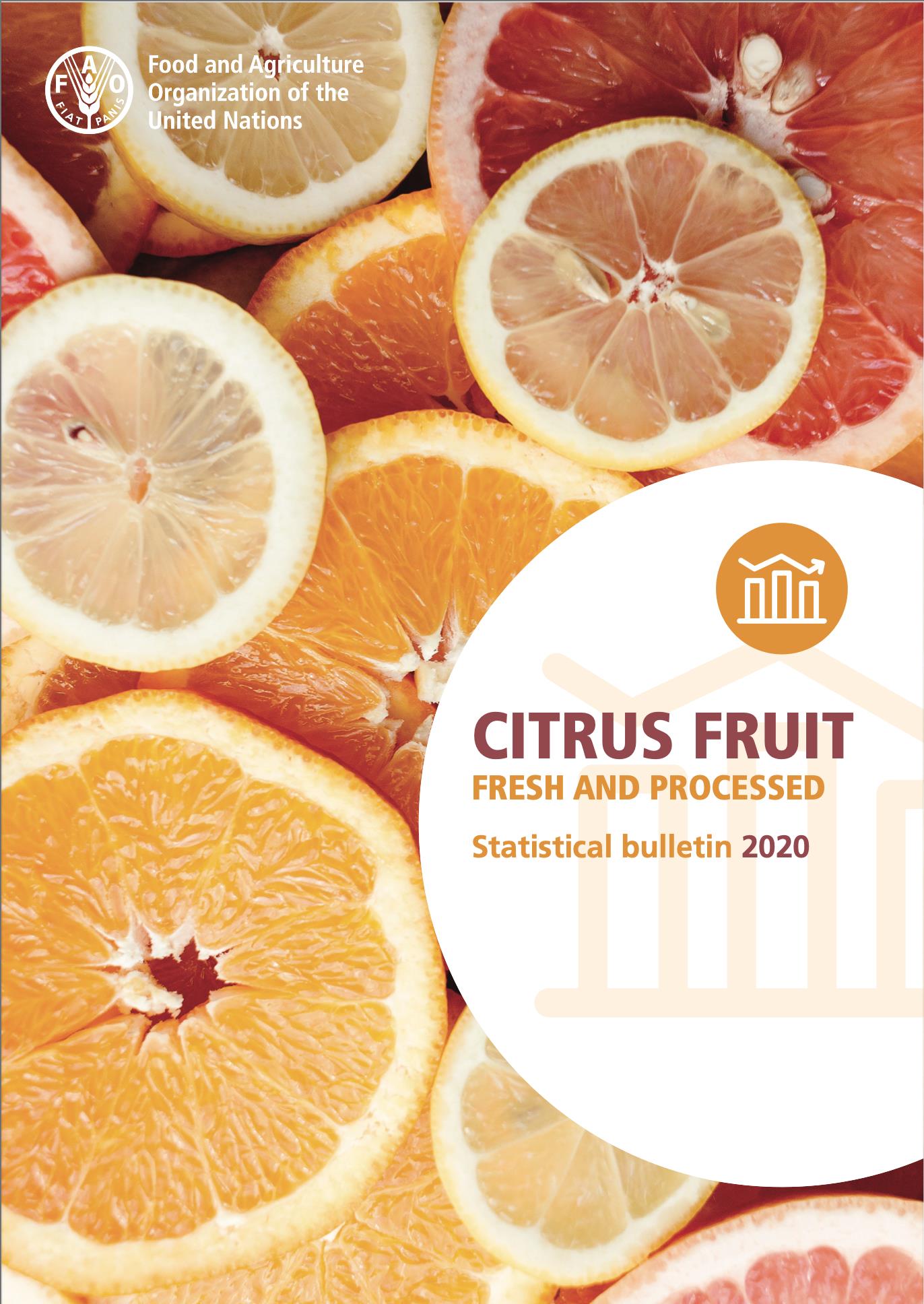
Citrus Fruit Fresh and Processed Statistical Bulletin 2020
08/09/2021
This report is issued on an annual basis to Members and Observers of the Intergovernmental Group on Citrus Fruit. It is prepared by the Market and Policy Analysis of Raw Materials, Horticulture and Tropical (RAMHOT) Products Team, Markets and Trade Division, FAO, Rome, and the tables contained in this document bring together governments' replies to the Group’s latest questionnaires, supplemented by other data available.
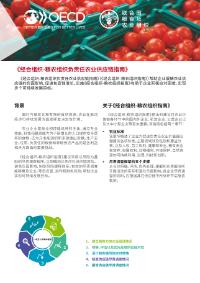
OECD-FAO Guidance for Responsible Agricultural Supply Chains - Flyer
01/09/2021
The OECD-FAO Guidance for Responsible Agricultural Supply Chains (OECD-FAO Guidance) helps enterprises mitigate adverse impacts in the agricultural supply chain and promote inclusive growth. Implementing the OECD-FAO Guidance can help companies proactively address harms and achieve many of the Sustainable Development Goals (SDGs).
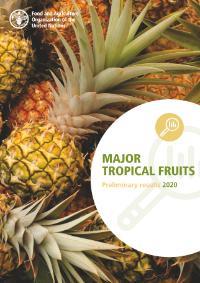
Major tropical fruits - Preliminary market results 2020
11/08/2021
The Tropical Fruits Market Review is issued on an annual basis to Members and Observers of the Sub-Group on Tropical Fruits of the Intergovernmental Group on Bananas and Tropical Fruits, which is a subsidiary body of the Committee on Commodity Problems (CCP). This document provides preliminary estimates for the 2020 market situation for the following major tropical fruits: Avocado, Mango, Papaya and Pineapple. Statistical tables related to imports and exports are also provided in the annex.
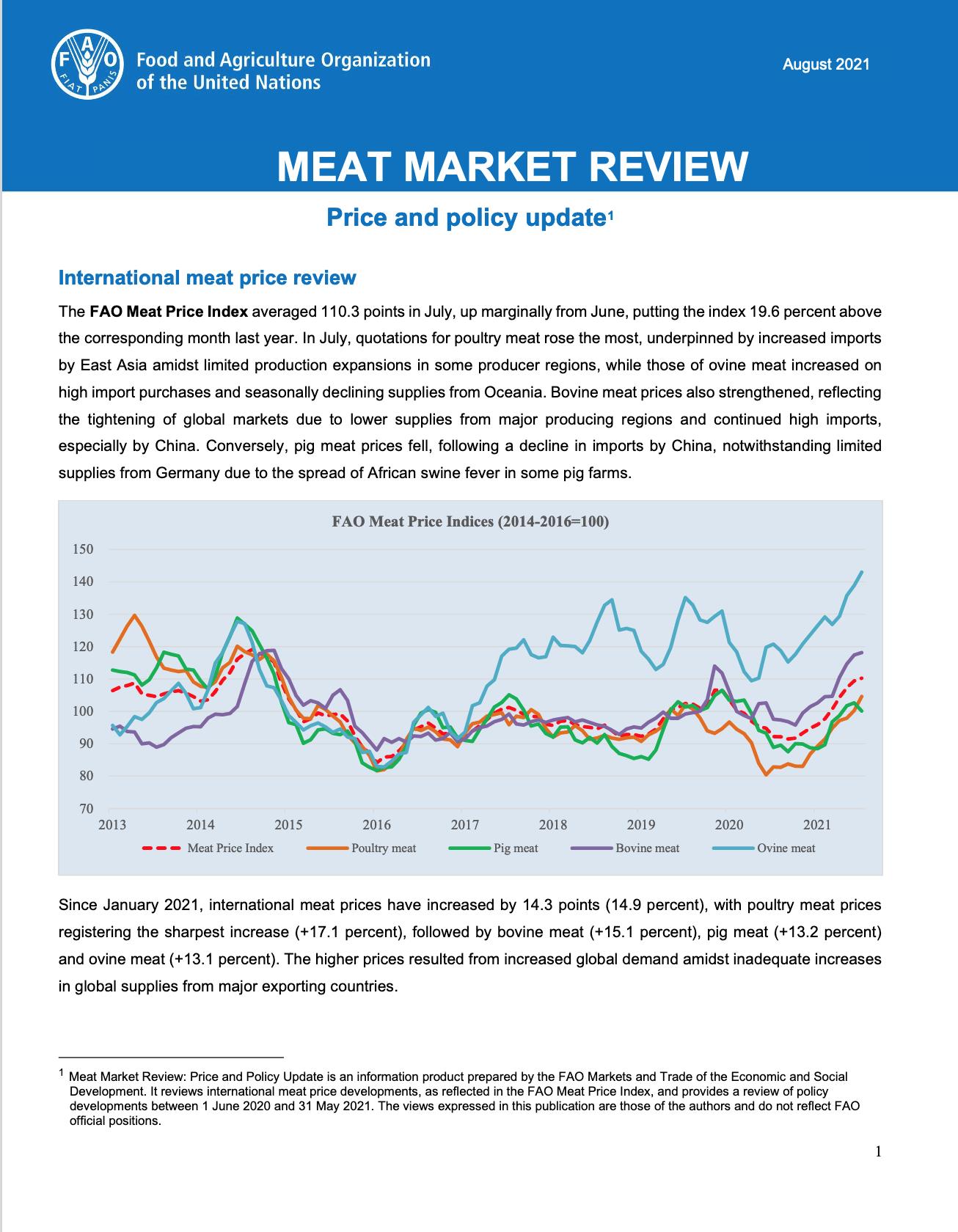
Meat Market Review: Price and policy update, August 2021
05/08/2021
The FAO Meat Price Index averaged 110.3 points in July, up marginally from June, putting the index 19.6 percent above the corresponding month last year. In July, quotations for poultry meat rose the most, underpinned by increased imports by East Asia amidst limited production expansions in some producer regions, while those of ovine meat increased on high import purchases and seasonally declining supplies from Oceania. Bovine meat prices also strengthened, reflecting the tightening of global markets due to lower supplies from major producing regions and continued high imports, especially by China. Conversely, pig meat prices fell, following a decline in imports by China, notwithstanding limited supplies from Germany due to the spread of African swine fever in some pig farms.
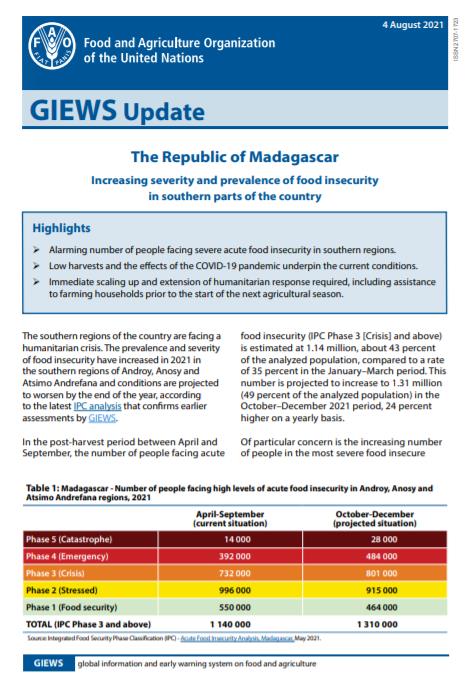
GIEWS Update - The Republic of Madagascar, 4 August 2021
04/08/2021
Alarming number of people facing severe acute food insecurity in southern regions. Low harvests and the effects of the COVID-19 pandemic underpin the current conditions. Immediate scaling up and extension of humanitarian response required, including assistance to farming households prior to the start of the next agricultural season.


